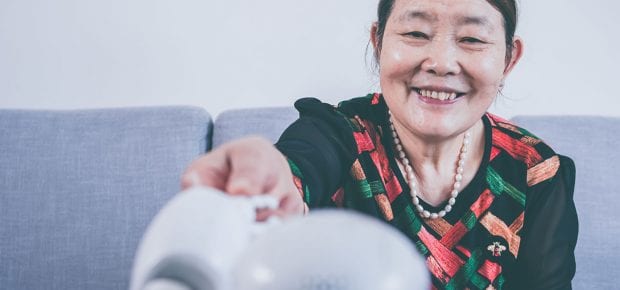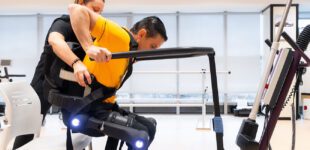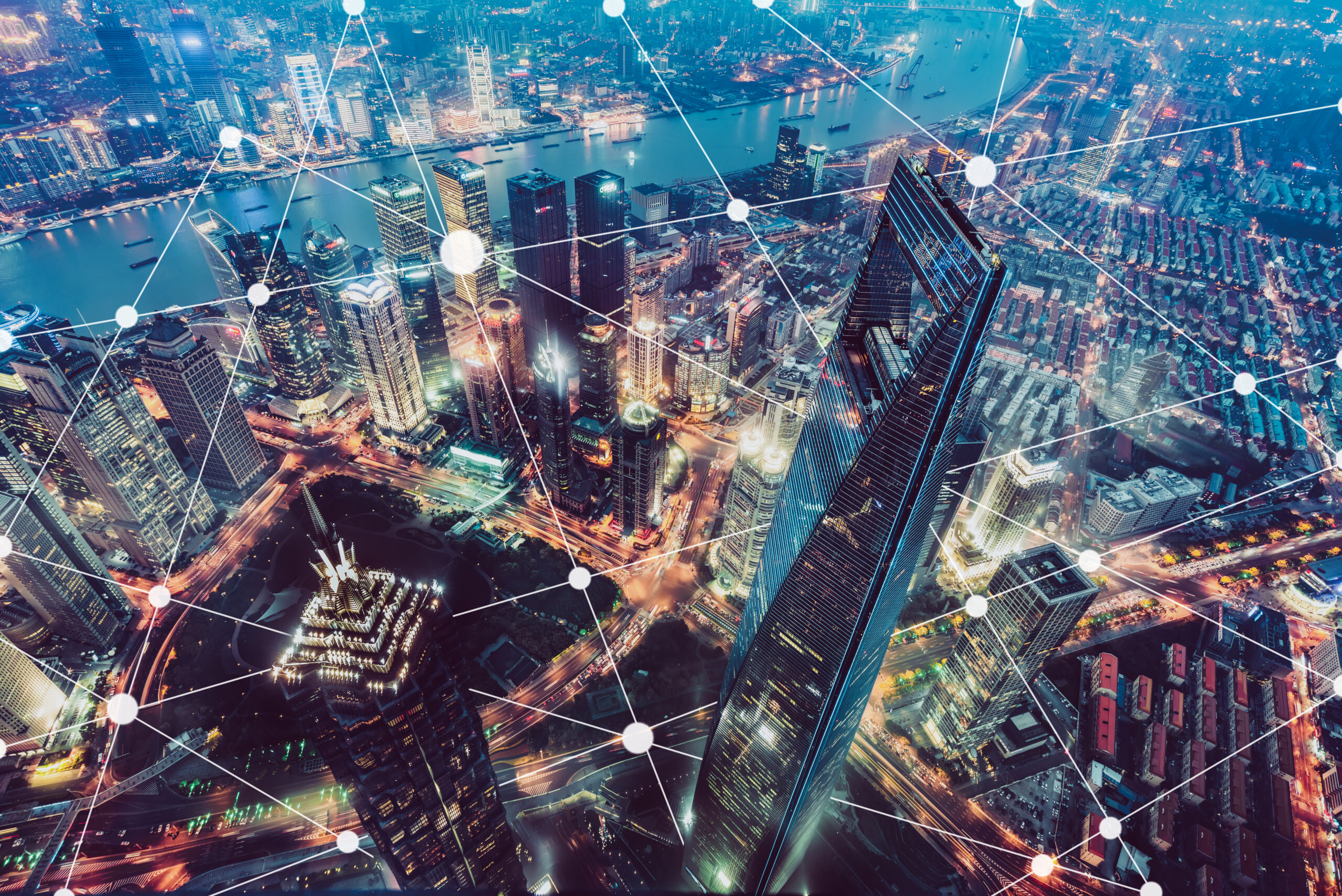April 22, 2021
A result of the isolation that individuals have endured due to the COVID-19 pandemic include feelings of loneliness and depression. To help those experiencing these types of feelings, technologists, researchers and healthcare workers are tapping into the benefits of using “robot friends” and VR for loneliness.
Depression increased after the outbreak of the virus and sharp mental health shifts occurred as COVID-19 cases began to rise around the globe.
IEEE member Jonathan Gratch says that physical touch and the way people give social cues in-person versus through a video call is biologically beneficial for our brains. Without those forms of social interaction happening regularly, our loneliness meter increases.
“Video conferencing can be cognitively demanding, as it might supercharge some of the social stressors found in real-world interactions,” says Gratch. “The fact that you see yourself makes you more aware of your appearance and reactions and increases your ‘impression management’. This is a known stressor.”
Another difficulty with video conferencing is our perception of screen boundaries. “For analog face-to-face, physically co-located interactions, our senses are not bounded by a screen border or controlled and mediated by a single camera angle or microphone placement,” says IEEE member Todd Richmond. “When we are in person, we are immersed in a space and that sense of immersion is something humans have learned and evolved to expect.”
Since we weren’t able to obtain the social interactions our bodies and brains were expecting or desiring during the COVID-19 crisis because of public safety concerns, robotics and virtual reality (VR) stepped in to fill the loneliness gaps.
Robot Friends Use AI to Keep Us Socially Updated
Social robots, or robotic friends, have provided an alternative for social interaction when human connection is limited.
Robots are being used in a variety of ways, as reported by IEEE Spectrum –– from Fribo, a robot that informs your friends and family members what you’re doing in your house so they know you’re actively moving, to these robots that are meant to be broken and yelled at in order to get out your negative emotions –– are ultimately helping you feel less alone.
Artificial intelligence (AI) and machine learning are often used in these health-managing robots to improve their interactions with you.
AI Voice Assistants for Older Adults
A recent article mentioned a study that used AI voice assistants that were “programmed to report sensor-based health information using visual and voice interfaces” for older adults living at home.
“Aging in your home is no longer a luxury for those most at-risk of transmitted viruses,” says IEEE Senior Member Marjorie Skubic, a professor of Electrical Engineering and Computer Science at the University of Missouri where the study was conducted. “Artificial intelligence is key to addressing this challenge by giving older adults better tools for managing their own health,” the article stated.
“To develop more innovative solutions that help keep people safe and make the world a better place, the IEEE Computational Intelligence Society recommends that all organizations actively combating COVID-19 leverage AI, one of the most powerful tools at our disposal,” states the article.
VR for Loneliness Helps Our Brains Feel Connected
Virtual Reality is another technology being used to help people currently going through isolation.
“Compared to video conferencing, VR tech is known to increase both physical and social presence,” says Gratch. “You feel like you are really at a place or really with a person. In terms of social interaction, it can help deal with some of the breakdowns in social cues.”
“VR brings a higher degree of immersion than a typical screen-based interaction,” adds Richmond. “Sharing a virtual space with someone in an immersive VR experience could very well lead to a better sense of “being there”. The shared space is key, and one problem with current video solutions.”
If VR is more beneficial than video conferencing, why aren’t we taking all of our work meetings and conducting all of our family gatherings in this way while we stay home? Richmond explains that this limitation is mostly because the devices are not as accessible as a computer or tablet.
“Most everyone has a screen (be it phone or computer), but very few have AR/VR,” says Richmond. “Once AR/VR gets more ubiquitous, more people will be able to experiment with the experiences, which will help advance the technology development and create new sets of social norms that will be necessary.”
Both Richmond and Gratch feel optimistic about the advancements happening in the virtual reality space. The pandemic has forced us all to adapt and make this type of technology a higher priority than ever before.
Other Technologies Being Used for Loneliness
Wearables, sensors and IoT are other methods being explored during the COVID-19 pandemic.
Overall, our desire for contact has moved technology forward to offer more effective solutions than ever before. While nothing can beat a hug from another person, robots and VR are making that absence feel a little less large.
“The pandemic has shown us that humans value contact, and that contact needs to move beyond the traditional screen boundary,” says Richmond.





 Meaningful Momentum or Running in Place?
Meaningful Momentum or Running in Place? AI Through Our Ages
AI Through Our Ages Liquid Infrastructure: Our Planet's Most Precious Resource
Liquid Infrastructure: Our Planet's Most Precious Resource The Impact of Technology in 2025
The Impact of Technology in 2025 Quantum and AI: Safeguards or Threats to Cybersecurity?
Quantum and AI: Safeguards or Threats to Cybersecurity? Why AI Can't Live Without Us
Why AI Can't Live Without Us Bits, Bytes, Buildings and Bridges: Digital-Driven Infrastructure
Bits, Bytes, Buildings and Bridges: Digital-Driven Infrastructure Impact of Technology in 2024
Impact of Technology in 2024 Emerging AI Cybersecurity Challenges and Solutions
Emerging AI Cybersecurity Challenges and Solutions The Skies are Unlimited
The Skies are Unlimited Smart Cities 2030: How Tech is Reshaping Urbanscapes
Smart Cities 2030: How Tech is Reshaping Urbanscapes Impact of Technology 2023
Impact of Technology 2023 Cybersecurity for Life-Changing Innovations
Cybersecurity for Life-Changing Innovations Smarter Wearables Healthier Life
Smarter Wearables Healthier Life Infrastructure In Motion
Infrastructure In Motion The Impact of Tech in 2022 and Beyond
The Impact of Tech in 2022 and Beyond Cybersecurity, Technology and Protecting Our World
Cybersecurity, Technology and Protecting Our World How Technology Helps us Understand Our Health and Wellness
How Technology Helps us Understand Our Health and Wellness The Resilience of Humanity
The Resilience of Humanity Harnessing and Sustaining our Natural Resources
Harnessing and Sustaining our Natural Resources Creating Healthy Spaces Through Technology
Creating Healthy Spaces Through Technology Exceptional Infrastructure Challenges, Technology and Humanity
Exceptional Infrastructure Challenges, Technology and Humanity The Global Impact of IEEE's 802 Standards
The Global Impact of IEEE's 802 Standards Scenes of our Cyber Lives: The Security Threats and Technology Solutions Protecting Us
Scenes of our Cyber Lives: The Security Threats and Technology Solutions Protecting Us How Millennial Parents are Embracing Health and Wellness Technologies for Their Generation Alpha Kids
How Millennial Parents are Embracing Health and Wellness Technologies for Their Generation Alpha Kids Space Exploration, Technology and Our Lives
Space Exploration, Technology and Our Lives Global Innovation and the Environment
Global Innovation and the Environment How Technology, Privacy and Security are Changing Each Other (And Us)
How Technology, Privacy and Security are Changing Each Other (And Us) Find us in booth 31506, LVCC South Hall 3 and experience the Technology Moon Walk
Find us in booth 31506, LVCC South Hall 3 and experience the Technology Moon Walk Virtual and Mixed Reality
Virtual and Mixed Reality How Robots are Improving our Health
How Robots are Improving our Health IEEE Experts and the Robots They are Teaching
IEEE Experts and the Robots They are Teaching See how millennial parents around the world see AI impacting the lives of their tech-infused offspring
See how millennial parents around the world see AI impacting the lives of their tech-infused offspring Take the journey from farm to table and learn how IoT will help us reach the rising demand for food production
Take the journey from farm to table and learn how IoT will help us reach the rising demand for food production Watch technical experts discuss the latest cyber threats
Watch technical experts discuss the latest cyber threats Explore how researchers, teachers, explorers, healthcare and medical professionals use immersive technologies
Explore how researchers, teachers, explorers, healthcare and medical professionals use immersive technologies Follow the timeline to see how Generation AI will be impacted by technology
Follow the timeline to see how Generation AI will be impacted by technology Learn how your IoT data can be used by experiencing a day in a connected life
Learn how your IoT data can be used by experiencing a day in a connected life Listen to technical experts discuss the biggest security threats today
Listen to technical experts discuss the biggest security threats today See how tech has influenced and evolved with the Games
See how tech has influenced and evolved with the Games Enter our virtual home to explore the IoT (Internet of Things) technologies
Enter our virtual home to explore the IoT (Internet of Things) technologies Explore an interactive map showcasing exciting innovations in robotics
Explore an interactive map showcasing exciting innovations in robotics Interactively explore A.I. in recent Hollywood movies
Interactively explore A.I. in recent Hollywood movies Get immersed in technologies that will improve patients' lives
Get immersed in technologies that will improve patients' lives